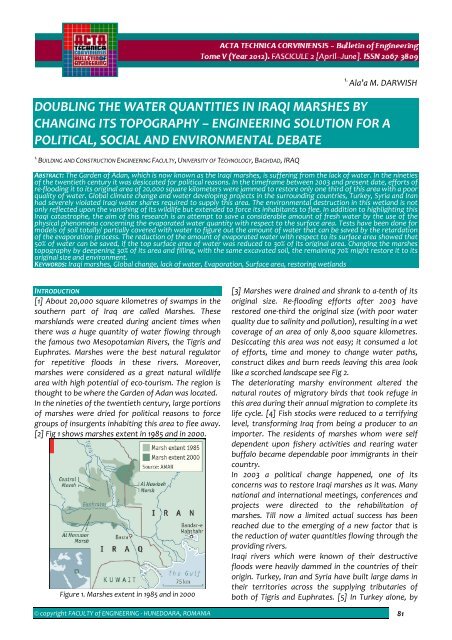Editorial & Advisory Board - Acta Technica Corviniensis
Editorial & Advisory Board - Acta Technica Corviniensis
Editorial & Advisory Board - Acta Technica Corviniensis
Create successful ePaper yourself
Turn your PDF publications into a flip-book with our unique Google optimized e-Paper software.
1.<br />
Ala’a M. DARWISH<br />
DOUBLING THE WATER QUANTITIES IN IRAQI MARSHES BY<br />
CHANGING ITS TOPOGRAPHY – ENGINEERING SOLUTION FOR A<br />
POLITICAL, SOCIAL AND ENVIRONMENTAL DEBATE<br />
1.<br />
BUILDING AND CONSTRUCTION ENGINEERING FACULTY, UNIVERSITY OF TECHNOLOGY, BAGHDAD, IRAQ<br />
ABSTRACT: The Garden of Adan, which is now known as the Iraqi marshes, is suffering from the lack of water. In the nineties<br />
of the twentieth century it was desiccated for political reasons. In the timeframe between 2003 and present date, efforts of<br />
re‐flooding it to its original area of 20,000 square kilometers were jammed to restore only one third of this area with a poor<br />
quality of water. Global climate change and water developing projects in the surrounding countries, Turkey, Syria and Iran<br />
had severely violated Iraqi water shares required to supply this area. The environmental destruction in this wetland is not<br />
only reflected upon the vanishing of its wildlife but extended to force its inhabitants to flee. In addition to highlighting this<br />
Iraqi catastrophe, the aim of this research is an attempt to save a considerable amount of fresh water by the use of the<br />
physical phenomena concerning the evaporated water quantity with respect to the surface area. Tests have been done for<br />
models of soil totally/ partially covered with water to figure out the amount of water that can be saved by the retardation<br />
of the evaporation process. The reduction of the amount of evaporated water with respect to its surface area showed that<br />
50% of water can be saved, if the top surface area of water was reduced to 30% of its original area. Changing the marshes<br />
topography by deepening 30% of its area and filling, with the same excavated soil, the remaining 70% might restore it to its<br />
original size and environment.<br />
KEYWORDS: Iraqi marshes, Global change, lack of water, Evaporation, Surface area, restoring wetlands<br />
INTRODUCTION<br />
[1] About 20,000 square kilometres of swamps in the<br />
southern part of Iraq are called Marshes. These<br />
marshlands were created during ancient times when<br />
there was a huge quantity of water flowing through<br />
the famous two Mesopotamian Rivers, the Tigris and<br />
Euphrates. Marshes were the best natural regulator<br />
for repetitive floods in these rivers. Moreover,<br />
marshes were considered as a great natural wildlife<br />
area with high potential of eco‐tourism. The region is<br />
thought to be where the Garden of Adan was located.<br />
In the nineties of the twentieth century, large portions<br />
of marshes were dried for political reasons to force<br />
groups of insurgents inhabiting this area to flee away.<br />
[2] Fig 1 shows marshes extent in 1985 and in 2000.<br />
Figure 1. Marshes extent in 1985 and in 2000<br />
[3] Marshes were drained and shrank to a‐tenth of its<br />
original size. Re‐flooding efforts after 2003 have<br />
restored one‐third the original size (with poor water<br />
quality due to salinity and pollution), resulting in a wet<br />
coverage of an area of only 8,000 square kilometres.<br />
Desiccating this area was not easy; it consumed a lot<br />
of efforts, time and money to change water paths,<br />
construct dikes and burn reeds leaving this area look<br />
like a scorched landscape see Fig 2.<br />
The deteriorating marshy environment altered the<br />
natural routes of migratory birds that took refuge in<br />
this area during their annual migration to complete its<br />
life cycle. [4] Fish stocks were reduced to a terrifying<br />
level, transforming Iraq from being a producer to an<br />
importer. The residents of marshes whom were self<br />
dependent upon fishery activities and rearing water<br />
buffalo became dependable poor immigrants in their<br />
country.<br />
In 2003 a political change happened, one of its<br />
concerns was to restore Iraqi marshes as it was. Many<br />
national and international meetings, conferences and<br />
projects were directed to the rehabilitation of<br />
marshes. Till now a limited actual success has been<br />
reached due to the emerging of a new factor that is<br />
the reduction of water quantities flowing through the<br />
providing rivers.<br />
Iraqi rivers which were known of their destructive<br />
floods were heavily dammed in the countries of their<br />
origin. Turkey, Iran and Syria have built large dams in<br />
their territories across the supplying tributaries of<br />
both of Tigris and Euphrates. [5] In Turkey alone, by<br />
© copyright FACULTY of ENGINEERING ‐ HUNEDOARA, ROMANIA 81

















